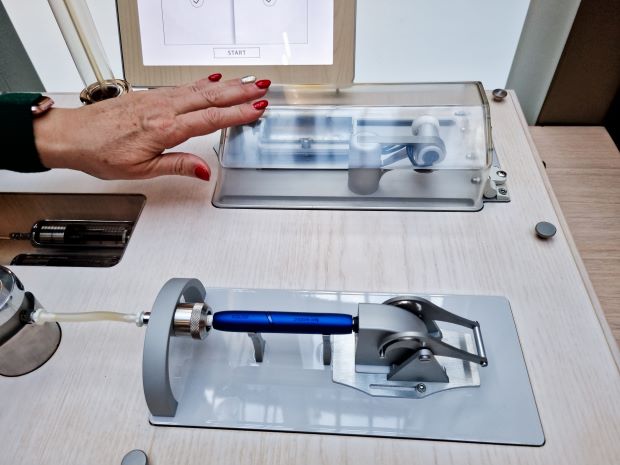- Daily & Weekly newsletters
- Buy & download The Bulletin
- Comment on our articles
Building a smoke-free future: The science behind alternative tobacco products
Smoke-free products such as electronic cigarettes and vaping devices are no longer a novelty, but how they are regulated around the world is a continually changing story.
Belgium for example, home to the European institutions, currently adopts a less than enthusiastic approach. It regulates alternatives products in the same way as traditional cigarettes, so strict rules and high taxation reign.
With 24% of the population in Belgium smoking, according to a Foundation against Cancer survey in 2022, addressing the public health issue has become something of a hot potato for the country’s legislators.
Although its superior health council released an advisory report in 2022 recognising the role alternatives could play in encouraging smokers to quit, Belgium continues to ban many of the smoke-free products on the market.
At the heart of the debate is ongoing scientific research about the relative harm of these products by a growing body of scientists. Not surprisingly, global tobacco companies are at the forefront and have been financing studies for more than a decade. One notable one is Philip Morris International (PMI), which operates a state-of-the-art research and development centre in Neuchâtel, Switzerland, called the Cube.
PMI has invested over €9 billion in the development and scientific testing of smoke-free products since 2009, employing a dedicated team of more than 900 scientists, engineers and support staff.
The company aims to achieve half of its sales from new products that are exclusively for adult smokers who can’t or don’t want to stop. Its message is: “If you don’t smoke, don’t start. If you smoke, quit. If you don’t quit, change.”
The science

Beyond the futuristic lakeside glass space that houses the Cube, the feature that incites the most interest from visitors is a simple desktop exhibit.
It demonstrates the difference between inhaling a traditional cigarette and an electronic one. The first burns at temperatures rising to between 600 and 800 degrees, releasing an acrid tobacco smoke that deposits dark yellow carbon particles on a filter.
The second is heated to 350 degrees and emits a vapour that leaves barely a deposit; this is the aerosol of an IQOS, PMI’s flagship heated tobacco product.
Heating rather than burning
At the crux of its switch to alternatives is the decrease in harmful toxins and carcinogens that are responsible for smoking-related diseases. The IQOS device generates on average a reduction of 90-95% of toxic materials compared to cigarette smoke.
Cigarette smoke contains more than 6,000 chemicals, with over 100 of them classified as harmful or potentially harmful. Heating tobacco rather than burning it results in fewer dangerous chemicals.
“With e-cigarettes or heated tobacco, you can still deliver nicotine but you eliminate the combustion and significantly reduce the toxic levels,” explains Ignacio Gonzalez Suarez, head of scientific engagement. “Nicotine is addictive and not risk-free, but it’s not the primary cause of health problems.”
Independent clinical studies in the US and Japan evaluated three groups of adult smokers over 90 days: one continued to smoke cigarettes; the second stopped smoking; the third switched completely to IQOS. Blood and urine samples measured biomarkers for exposure to harmful chemicals. “There was a similar response when people stopped or switched, with IQOS users achieving 95% reduction in exposure,” according to Gonzalez Suarez, who says communicating independently-assessed scientific studies is now key.

Range of alternative products
Since the start of PMI’s conversion, it has been evolving its devices, with customer feedback proving crucial in developing new products that need less recharging, come in pocket-size versions and offer a smoother experience.
“Some consumers want a product that delivers an experience as close as possible to a traditional cigarette,” says Gonzalez Suarez. “Others want to consume nicotine but want something that is completely different to a cigarette.” Care is taken to minimise use by non-intended audiences, such as non-smokers, ex-smokers and young people.
“The best product for you is the one that keeps you away from cigarettes,” he says. He cites the use of snus in Sweden (it’s banned in the rest of the EU), which has the lowest smoking rate for males in Europe. Other country-wide preferences for certain products include e-cigarettes in the UK and heated tobacco products in Japan.
He see the constant need for varieties an opportunity. “It’s a way of driving innovation in different categories and it’s a fundamental piece of our goal. We essentially want to make the cigarette obsolete.”
Variation in regulations
PMI is probably the most controversial evangelist for the end of cigarettes, and there are no signs of it veering from this path. “We believe that we can move away from traditional cigarettes to health and wellness areas,” says PMI’s regional communications director Mário Moniz Barreto on the company’s long-term vision. The company’s contentious €1 billion takeover of Vectura, a British pharmacy company that makes asthma inhalers, shows that it is not afraid of controversy as it doubles down on its ambition to move beyond tobacco.
The contrast between Belgium's mixed approach and PMI's commitment into this area underlines the discrepancy in perspectives towards alternatives to cigarettes. As PMI continues to invest heavily in science and research, it faces a regulatory landscape where some countries, like Belgium, remain sceptical about the potential benefits of these alternatives. This poses risks for policy makers as well as the tobacco companies.
Legislators are understandably wary of the tobacco industry proselytising the end of the cigarette. But as Belgian decision makers wrestle with the smoking paradox, they could also look at what their counterparts around Europe and beyond are doing to bring down smoking rates and improve public health.
This coverage is supported by PMI. This support enables the Bulletin to devote additional editorial resources to cover the topic more widely and deeply. The Bulletin’s editorial content is independent of its supporters.

















